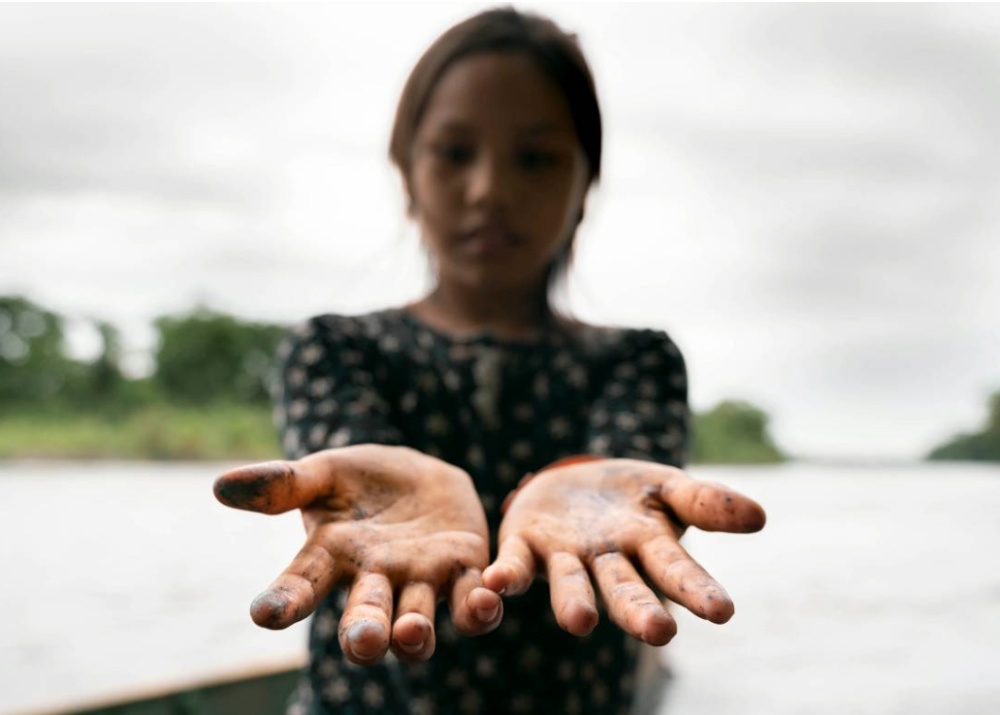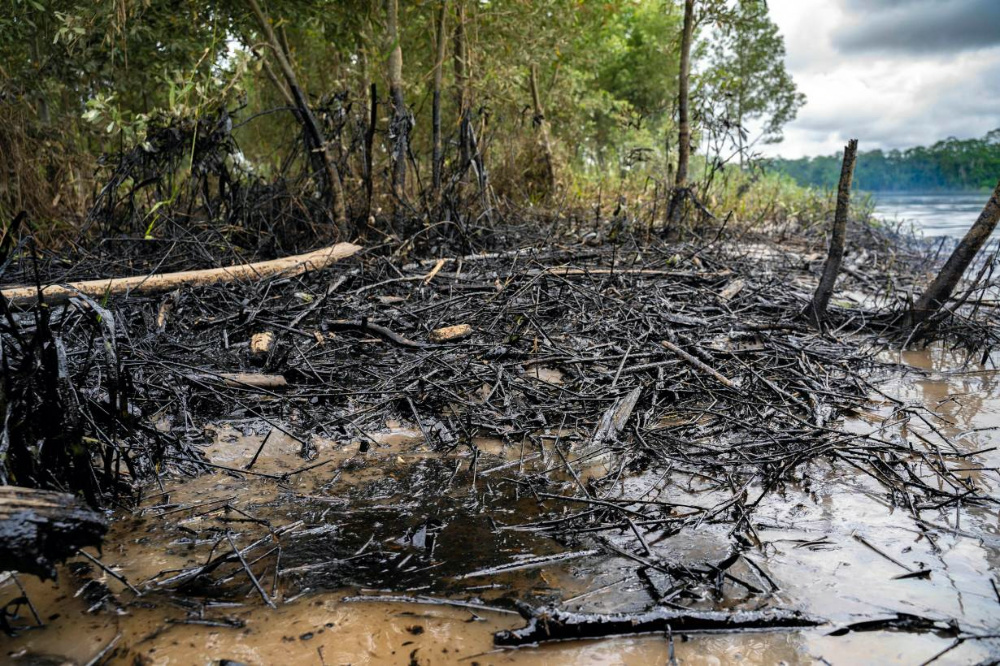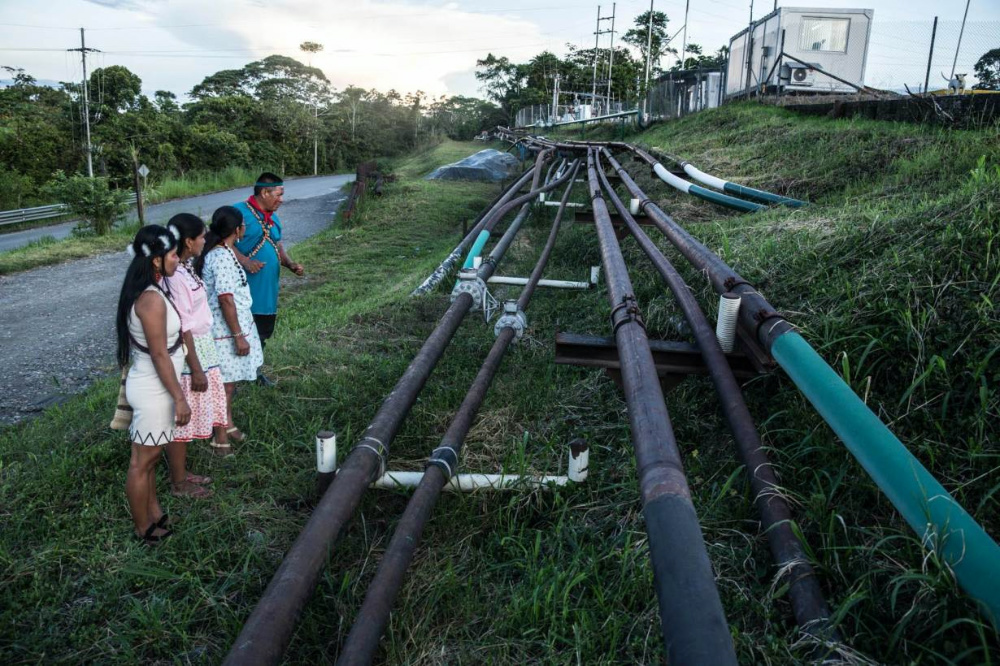
KIMBERLEY BROWN, of Thomson Reuters Foundation, reports from Quito in Ecuador…
Quito, Ecuador
Thomson Reuters Foundation
When the Kichwa community closed off their village near the Coca River in Ecuador’s northern Amazon rainforest in March to protect themselves from the coronavirus pandemic, they planned to live off fishing and whatever food they could grow.
But about two weeks into their quarantine, two damaged oil pipelines leaked thousands of barrels of crude into the river, spreading along the banks and contaminating the water, said Carlos Jipa, leader of the Indigenous community.
Last week, a lower court judge ruled against the 105 mostly Kichwa communities affected by the spill, in a lawsuit that demanded urgent environmental and community reparations from the Ecuadorian government and oil companies responsible.

An Indigenous girl’s hands are stained from crude oil after playing along the riverbanks near the community of San Pedro de Rio Coca, Sucumbios, in northern Ecuadorian Amazon, on 18th April. PICTURE: Telmo Ibarburu/Amazon Frontlines.
Already feeling trapped by quarantine, the more than 27,000 Indigenous people living along the Coca and Napo rivers now cannot farm or fish on their own territory because of the oil in the water, Jipa said.
“We are trapped again,” said the local leader, who is president of the Kichwa Indigenous federation, FCUNAE.
“Just thinking that my brothers and sisters will not be able to eat due to the contamination – I’m worried.”
– Carlos Jipa, leader of the Indigenous Kichwa community near the Coca River in Ecuador’s northern Amazon.
“Just thinking that my brothers and sisters will not be able to eat due to the contamination – I’m worried.”
Climate experts have long warned about the damage that the oil industry is causing to the Amazon rainforest, which plays a vital role in regulating the Earth’s climate by absorbing carbon dioxide, one of the main drivers of rising global temperatures.
The recent oil spill, which environmentalists say was the largest in Ecuador in more than a decade, started on 7th April along the Coca River, in the northeast, when a landslide caused by severe soil erosion ruptured two oil pipelines.
By the time the pipelines’ owners – state-run oil company Petroecuador and privately-owned OCP Ecuador – halted operations, more than 15,000 barrels of crude had flowed downstream.
The suit filed by FCUNAE, other human rights groups and affected residents said Petroecuador, OCP and the environment and energy ministries had violated the constitutional rights of Indigenous people and the rights of nature.
The plaintiffs also said authorities had not done enough to clean up the spill or help local populations.
The two oil companies told the Thomson Reuters Foundation that they had alerted local and national authorities as soon as they detected the spill, and worked together to coordinate a community response which began the following day.
They provided more than 1.7 million litres of water and 25,000 food kits to local communities, dispatched medical teams to the contaminated areas, and spent $US3.8 million on the cleanup operation, both companies said in separate email responses.
“The aid delivered to the communities was immediate, within all the limitations imposed due to the health crisis caused by COVID-19,” wrote Santiago Sarasti, OCP Ecuador’s safety, health and environment manager.

The spill of more than 15,000 barrels of crude from two major pipelines was accompanied by flash floods, extending the reach of the contamination and affecting local crops planted along the riverbanks. Amarunmesa, Orellana, Ecuadorian Amazon, 2020. PICTURE: Telmo Ibarburu/Amazon Frontlines
The pipelines became fully operational again in May, after Petroecuador and OCP built bypass pipelines around the ruptures.
Ecuador’s Ministry of Energy and Non-Renewable Natural Resources responded to requests for comment by directing the Thomson Reuters Foundation to Petroecuador.
The environment ministry said in an emailed statement that it had alerted both companies that their equipment was at risk immediately after national park rangers detected the landslide.
But nobody warned the populations downriver of the landslide or the oil spill, said Jipa, so they had no chance to prepare for a sudden lack of food and fresh water.
In his verdict, the judge said it was undeniable that an oil spill had affected the communities living along the river. But he rejected the lawsuit, saying his court – which processes constitutional rights violations – was the incorrect legal venue. He told the plaintiffs to try administrative or criminal avenues.
Also, the aid that the oil companies provided afterwards did not reach everyone in need, he added.
Many people are still walking up to four kilometres through the jungle to find smaller streams to access clean water, Jipa said.
In his verdict, the judge said it was undeniable that an oil spill had affected the communities living along the river.
But he rejected the lawsuit, saying his court – which processes constitutional rights violations – was the incorrect legal venue. He told the plaintiffs to try administrative or criminal avenues.
After the verdict, the plaintiffs’ lawyer Lina Maria Espinosa called the court’s decision “unacceptable”, and said the communities planned to appeal the ruling.
An extractive economic model built on exporting natural resources is “destroying people’s lives and the Amazon rainforest”, she told the Thomson Reuters Foundation.

Indigenous leaders Nemonte Nenquimo, Emergildo Criollo and Flor Tangoy stand alongside oil pipelines in Sucumbios, Ecuadorian Amazon. PICTURE: Mitch Anderson/Amazon Frontlines
Indigenous leaders across the Amazon have recently stepped up demands to stop the extraction of oil and other resources.
Last month, Indigenous groups in Ecuador accused major European banks of “double standards” for financing oil exports from the region while also backing action on climate change.
Oil is one of Ecuador’s main exports, accounting for nine per cent of its GDP in 2019, with the vast majority of operations located in the Amazon rainforest, according to government data.
Isabel Carolina Bernal Carrera, geology professor at the National Polytechnic School in Quito, said scientists have long known the Coca River area is surrounded by unstable terrain.
The region is located near an active volcano in an earthquake zone, and soil erosion along the river has happened naturally for thousands of years after eruptions, she noted.
Human activity, including the construction of highways and pipelines that line the river and a nearby dam, has accelerated the erosion, with catastrophic results, she said.
The country’s tallest waterfall, San Rafael, collapsed in February, just two kilometres from the pipelines, an event scientists attributed to massive soil erosion.
Both OCP’s Sarasti and experts with Petroecuador said by email that they had monitored the area carefully since then. But Sarasti said that, as with volcanoes or earthquakes, it was difficult to predict the scope and impact of erosion in advance.
Small and medium-sized oil spills in the Amazon are a common occurrence, said Kelly Swing, director and founder of the Tiputini Biodiversity Station in the Yasuni National Park.
Even the best cleanup methods with the latest technology will leave toxic oil residue in soil and water, he added.
“When [the oil] touches the riverbanks it starts getting absorbed into the soil, and then the water can rise and cover it so you’re not seeing it,” said Swing, adding the residues could remain for decades.
Jipa, who has now seen three major oil spills near his home in his lifetime, said his community is constantly living with the consequences of the oil industry’s push into the Amazon.
“We had just recovered from the last spill, and again we’re hit with another,” he said.





